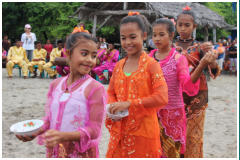

Total Solar Eclipse of 2016
From Bali to Borneo
CULTURE
The Republic of Indonesia, the world's fourth most populous nation, has 203 million people living on nearly 1000 permanently settled islands (there are over 17500 islands). Nearly 300 ethnic groups with 750 languages and dialects range in population from the Javanese (about 70 million) and Sundanese (about 30 million) on Java, to people numbering in the thousands on remote islands. The official language of Indonesia is ‘Indonesian’ or ‘Bahasa Indonesia’.BALI
Much of the outside world's image of Indonesia is based on Bali, which is a prime tourist destination. However, Balinese culture is very different from the national mainstream, especially in its unique Hindu-animist religion. Inscriptions from the ninth and tenth centuries AD record the emergence of Balinese kingdoms that would later fall under Javanese domination. In the sixteenth century, King Batu Renggong of Gelgel unified Bali. The social and religious order that was established at that time continues to the present day. Bali culture is steeped in a rich tradition and spirituality that focuses mainly on art and religion, with the two often expressed through each other. Most Balinese people are an artist of some kind and spend their leisure time working on hobbies and artwork that have been passed down through generations. Many public areas, homes and paddy fields are decorated by detailed paintings, intricate carvings, fine weaving, extraordinary rice decorations and artworks that pay religious homage. Rituals seek to maintain cosmic harmony among the three levels of the Hindu Universe: that of the gods above the mountain peaks, the demons below the earth and sea and the human world in between. Temples are the meeting points of the humans and gods. There are temples for almost all aspects of life including those for ancestors, rice fields and the village. Offerings of palm leaves, flowers and foodstuffs are made daily in the shrines that are present at every home. INDONESIA Indonesia is centrally-located along ancient trading routes between the Far East, South Asia and the Middle East, resulting in many cultural practices being strongly influenced by a multitude of religions mainly Islam, Hinduism, Buddhism, Protestantism, Catholicism, and Confucianism. The largest religious group in Indonesia is Islam with almost 86% of Indonesians being Muslims. Indonesia is also the most populous Muslim-majority nation in the world. Indonesia is culturally rich. Indonesian art and culture are intertwined with religion and age- old traditions from the time of early migrants with Western thoughts brought by Portuguese traders and Dutch colonists. Indonesia is a collectivist society that puts greater importance on the group rather than on individuals. The basic principles which guide life include the concepts of mutual assistance or ‘gotong royong’ and consultations or ‘musyawarah’ to arrive at a consensus or ‘mufakat’. Derived from rural life, this system is still very much in use in community life throughout the country.DANCE
Almost all of the islands of Indonesia have their own dance styles, but those best known are from Bali and Java. Dance and drama are practically inseparable, and performances are almost always accompanied by gamelan music. Dancers take their art very seriously and practice for endless hours, usually from childhood, under the oversight of an expert. MUSIC Indonesian gamelan music is the best known Indonesian music. This instrumental ensemble music played on a variety of metal pots, gongs, and drums (the word gamelan refers to the collection of instruments themselves) is a blend of exotic harmony and tone. Said to have been created by a Javanese king in the 3rd century, the gamelan has retained its ceremonial function in the royal courts of Java and Bali, while evolving into a modern folk form.

























